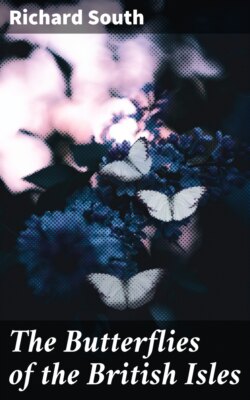Читать книгу The Butterflies of the British Isles - Richard South - Страница 15
На сайте Литреса книга снята с продажи.
The Black-veined White (Aporia cratægi).
ОглавлениеTable of Contents
The Black-veined White (Plate 4) may be at once recognized by its roundish white wings and their conspicuous veins, which latter are black in the male butterfly, and in the female brownish on the main ones (nervures) and black on the branches (nervules). As the scales on the wings are denser in the male than in the female, the former always appears to be the whiter insect. On the outer margin of the fore wings there are more or less triangular patches of dusky scales, and these in occasional specimens are so large that their edges almost or quite meet, and so form an irregular, dusky border to the fore wings. These patches are also present on the hind wings, but are not so well defined. Sometimes the patches are absent from all the wings. The fringes of the wings are so short that they appear to be wanting altogether. The early stages are figured on Plate 3.
The egg is upright and ribbed from about the middle to the curiously ornamented top, which appears to be furnished with a sort of coronet. The colour is at first honey-yellow, then darker yellow, and just before the caterpillar hatches, greyish. The eggs are laid in a cluster on the upper side of a leaf of sloe, hawthorn, or plum, etc., in the month of July.
The caterpillar when full grown is tawny brown with paler hairs arising from white warts; the stripes along the sides and back are black. The under parts are greyish. The head, legs, and spiracles are blackish. Caterpillars hatch from the egg in August, and then live together in a common habitation which is formed of silk and whitish in colour. They come out in the morning and again in the evening to feed, but a few leaves are generally enclosed in their tenement. In October they seem to retire for the winter and reappear in the spring. During May they become full grown and then enter the chrysalis state. The butterflies are on the wing at the end of June and in July.
Larger Image
Pl. 4.
Black-veined White Butterfly.
1, 2 male; 3, 4 female.
Pl. 5.
Large White Butterfly.
Eggs, natural size and enlarged; caterpillar and chrysalids.
The chrysalis is creamy white, sometimes tinged with greenish, and dotted with black.
This butterfly was mentioned as English by Merret in 1667, and by Ray in 1710. Albin in 1731, who wrote of it as the White Butterfly with black veins, figures the caterpillar and the chrysalis, and states that caterpillars found by him in April turned to chrysalids early in May and to butterflies in June. Moses Harris in 1775 gave a more extended account of the butterfly's life-history, and what he then wrote seems to tally almost exactly with what is known of its habits to-day. This species has seemingly always been somewhat uncertain in its appearance in England. Authors from Haworth (1803) to Stephens (1827) mention Chelsea, Coombe Wood in Surrey, and Muswell Hill in Middlesex, among other localities for the butterfly. It has also been recorded at one time or another, between 1844 and 1872, from many of the Midland and Southern counties. In 1867 it was found in large numbers, about mid-summer, in hay fields in Monmouthshire. The latest information concerning the appearance of the species in South Wales relates to the year 1893, when several caterpillars and four butterflies were noted on May 22 in the Newport district. At one time it was not uncommon in the New Forest, but no captures of the butterfly in Hampshire have been recorded during the last quarter of a century. At the present time it is probably most regularly obtained in a Kentish locality, presumably in the Isle of Thanet, which is only known to a few collectors. It may be mentioned that some thirty years ago caterpillars of the Black-veined White could be obtained from a Canterbury dealer at a few shillings per gross.
The species is widely distributed, and often abundant, on the Continent, and its range extends through Western and Northern Asia to Yesso, Northern Japan.
